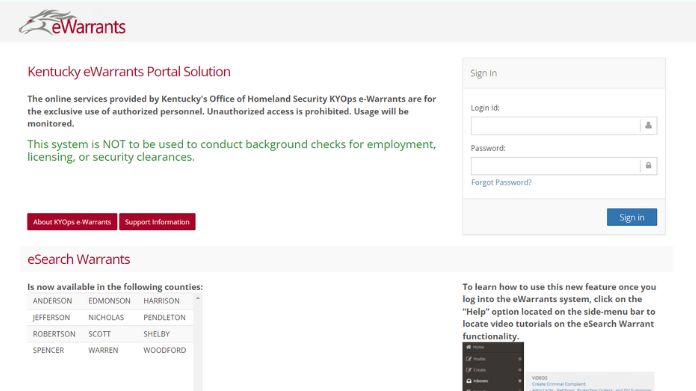Welcome to the dynamic world of eWarrants in Kentucky, a revolutionary system reshaping the landscape of legal and law enforcement processes in the Bluegrass State.
Have you ever wondered how technology is transforming the way warrants are handled, ensuring swifter justice and enhanced public safety? The eWarrants system in Kentucky stands at the forefront of this transformation, offering a fascinating glimpse into the future of judicial efficiency.
Join us on an enlightening journey as we explore how this cutting-edge technology streamlines warrant management, making it more accurate, secure, and efficient than ever before.
Stay tuned, engage with our insights, and discover how eWarrants in Kentucky is not just a system but a beacon of modern judicial innovation. Don’t just read about change – be a part of it.
Share your thoughts and experiences, and let’s delve deeper into how technology like eWarrants is revolutionizing the legal landscape in Kentucky and beyond.
The eWarrants in Kentucky represent a significant advancement in the management and execution of warrants within the state’s judicial system.
Developed and implemented to streamline the warrant process, eWarrants KY Gov has transformed the way law enforcement and judicial authorities interact with warrant information.
This article provides an in-depth understanding of the eWarrants system in Kentucky, exploring its inception, functionality, impact, and the steps involved in its use.
Background of eWarrants in Kentucky
The eWarrants system in Kentucky was introduced as a response to a growing need for a more efficient and accurate way of handling warrants.
Before its inception, the process of issuing, managing, and executing warrants was largely manual, leading to delays and potential errors.
The system was launched to address these issues and to provide a more secure and streamlined process for all parties involved.
Key Features and Functionality
The eWarrants system in Kentucky is characterized by several key features and functionalities that significantly enhance the efficiency and effectiveness of the state’s warrant management process.
These include:
- Electronic Issuance of Warrants: The system allows for the digital creation, signing, and issuance of warrants. This replaces the traditional paper-based process, making it faster and more efficient.
- Real-Time Access and Updates: Law enforcement and judicial officers have instant access to warrant information. This real-time capability ensures that officers are always working with the most current data, which is crucial for the timely execution of warrants.
- Integration with State and National Databases: The system is integrated with various state and national criminal databases. This integration provides comprehensive background information, which is essential for informed decision-making when issuing or executing warrants.
- Automated Data Entry: eWarrants in Kentucky reduces manual data entry, minimizing human error. Information can be pulled automatically from other systems, ensuring accuracy and consistency in the data.
- Secure Access and Authentication: Security is a paramount feature. The system requires secure logins and authentication processes, ensuring that sensitive information is only accessible to authorized personnel.
- Tracking and Management of Warrant Status: The system allows for efficient tracking of the status of warrants. Law enforcement can easily update the status of warrants, such as served or unserved, providing a clear and up-to-date picture of outstanding legal matters.
- Mobile Accessibility: For officers in the field, mobile access to the eWarrants system is crucial. This feature allows them to view and update warrant information directly from mobile devices, enhancing their ability to act quickly and effectively.
- Reporting and Analytics: The system includes robust reporting and analytics tools. These tools enable law enforcement agencies and judicial departments to generate reports on warrant trends, success rates, and other vital statistics, aiding in strategic planning and resource allocation.
- User-Friendly Interface: The design of the eWarrants system is user-friendly, ensuring that officers and judicial staff can navigate and utilize the system with minimal training.
- Training and Support: Comprehensive training and ongoing support are provided to all users of the system. This ensures that law enforcement and judicial personnel are proficient in using the eWarrants system and can troubleshoot any issues that arise.
Together, these features make the eWarrants system in Kentucky a powerful tool for streamlining the warrant process, enhancing the accuracy of the information, and improving the overall efficiency of law enforcement and judicial operations.
Using eWarrants System

Using the eWarrants system in Kentucky involves a series of detailed steps that ensure the efficient and secure handling of warrants from creation to execution.
These steps are designed to streamline the warrant process for law enforcement and judicial officials, making it more efficient and effective.
Here’s a breakdown of the typical workflow:
1. System Access and Authentication:
- Login: Authorized personnel, including law enforcement officers and judicial staff, log in to the eWarrants system using secure credentials.
- Two-Factor Authentication: For added security, a two-factor authentication process may be required to ensure that access is granted only to authorized users.
2. Warrant Creation and Submission:
- Entering Information: The user enters relevant information to create a warrant. This includes details about the suspect, the nature of the offense, and any other pertinent information.
- Automated Data Integration: The system may automatically integrate data from other databases to fill in certain fields, reducing manual entry and potential errors.
- Review and Submission: The officer reviews the information for accuracy and completeness before submitting the warrant for judicial review.
3. Judicial Review and Approval:
- Electronic Review: A judge or magistrate reviews the submitted warrant electronically. They may request additional information or clarification if needed.
- Approval or Denial: The judge approves or denies the warrant. If approved, it becomes an active warrant in the system.
4. Warrant Issuance and Distribution:
- Electronic Issuance: Once approved, the warrant is issued electronically within the system.
- Notification: Relevant law enforcement agencies are notified of the new warrant. This may include local police, sheriff’s departments, and other relevant entities.
5. Execution of Warrant:
- Access in the Field: Law enforcement officers can access warrant details via mobile devices while in the field.
- Execution: The warrant is executed according to law enforcement procedures and protocols.
6. Updating Warrant Status:
- Post-Execution Update: Following the execution of the warrant, officers update the system, indicating whether the warrant has been served or if the individual was apprehended.
- Record Keeping: The system automatically updates the records, ensuring an accurate and current status of all warrants.
7. Ongoing Management and Tracking:
- Active Warrants: Law enforcement can monitor and manage active warrants through the system.
- Analytics and Reporting: Agencies can generate reports and analyze data on warrants for strategic planning and resource allocation.
8. Training and Support:
- Continuous Training: Users receive ongoing training to stay updated on system features and best practices.
- Technical Support: Technical support is available for troubleshooting and assistance with system-related issues.
By following these steps, law enforcement and judicial personnel can effectively use the eWarrants system to enhance the warrant process, ensuring a more streamlined, accurate, and efficient handling of legal procedures in Kentucky.
Final Words
The eWarrants system in Kentucky is a testament to the state’s commitment to enhancing the efficiency, accuracy, and safety of its judicial and law enforcement processes.
By leveraging technology, Kentucky has set a benchmark for other states to follow in modernizing their warrant processes. The system not only streamlines the workflow for law enforcement but also ensures a higher standard of justice and public safety.
As technology evolves, so will systems like eWarrants. Kentucky may continue to enhance its capabilities, potentially integrating more advanced features such as AI and machine learning to predict and manage criminal activities more effectively.
The success of the eWarrants system in Kentucky could inspire similar adaptations in other states, leading to a more unified and efficient national approach to warrant management.
Frequently Asked Questions
Q. What is the eWarrants System in Kentucky?
Ans. The eWarrants system in Kentucky is a digital platform designed to streamline the process of issuing, managing, and executing warrants. It allows for the electronic creation, submission, and tracking of warrants, enhancing efficiency and accuracy in the judicial and law enforcement systems.
Q. Who Can Access the eWarrants System?
Ans. Access to the eWarrants system is restricted to authorized personnel, which typically includes law enforcement officers, judges, and other judicial staff who are involved in the warrant process.
Q. How Does the eWarrants System Improve the Warrant Process?
Ans. The eWarrants system improves the warrant process by providing real-time access to warrant information, reducing manual data entry errors, integrating with other databases for comprehensive background checks, and allowing for immediate updates and tracking of warrant statuses.
Q. Is the eWarrants System Secure?
Ans. Yes, the eWarrants system employs robust security measures, including secure logins, two-factor authentication, and encrypted data transmission to ensure the confidentiality and integrity of sensitive information.
Q. Can Warrants Be Tracked in Real-time Using the eWarrants System?
Ans. Yes, one of the key features of the eWarrants system is its ability to provide real-time tracking and updates of warrant statuses, which is crucial for the effective management and execution of warrants.
Q. Are There Training Programs Available for New Users of the eWarrants System?
Ans. Yes, comprehensive training programs are provided for new users, and ongoing support is available to ensure proficient and effective system use.
Q. How Does the eWarrants System Integrate With Other Databases?
Ans. The eWarrants system integrates with various state and national databases, allowing users to access and compile comprehensive information about individuals, including their criminal history, which is essential for informed decision-making in the warrant process.
Q. Can Law Enforcement Officers Access the eWarrants System Remotely?
Ans. Yes, the system is designed for mobile access, enabling law enforcement officers to view and update warrant information directly from the field.
Q. How Does the eWarrants System Benefit the Public?
Ans. By streamlining the warrant process, the eWarrants system ensures quicker and more accurate justice, enhances public safety, and promotes the efficient use of law enforcement resources.
Q. Who Provides Technical Support for the eWarrants System?
Ans. Technical support for the eWarrants system is provided by the Kentucky Office of the Courts or designated IT support teams, ensuring that any technical issues are promptly addressed.
